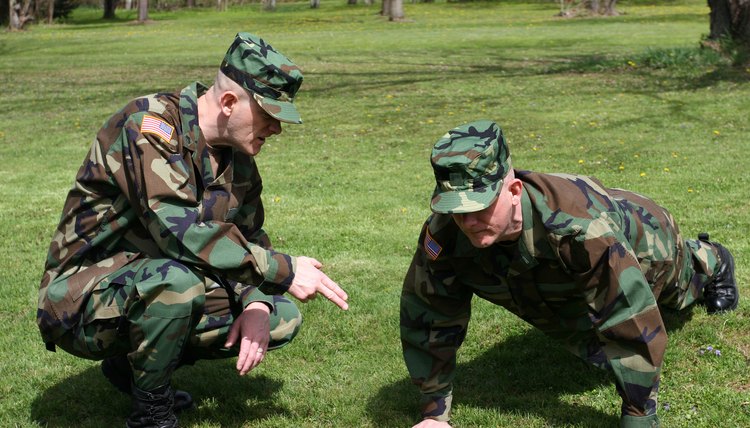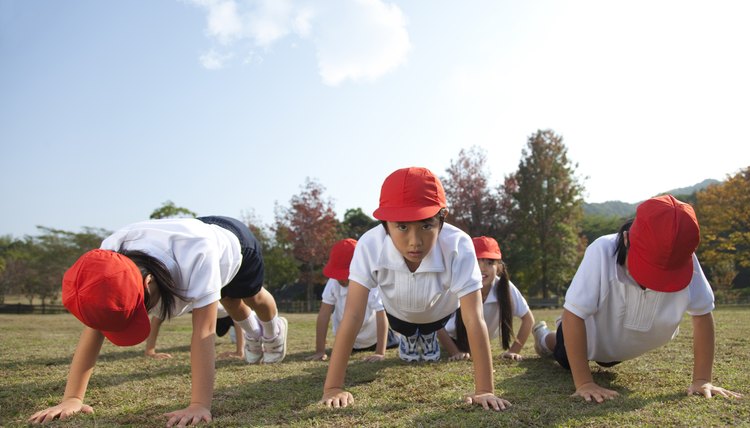The Disadvantages of Push-Up Tests

What do grade schoolers, law enforcement personnel and soldiers have in common? They're all subject to regular tests to measure their fitness levels. Push-up tests are often used to determine upper-body muscle endurance or stamina. While fit men might excel at this exercise, it can be a challenge for certain populations.
Types of Tests
Dozens of push-up tests exist. Some are timed to see how many you can do in 60 seconds or up to 2 minutes. The Army fitness test measures how many you can do in 1 minute, for example.
Others are set to a tempo, so that you push up in time to a beeping metronome. The President's Challenge Fitness Awards, administered in many public schools, is an example of this type of test. Once you can't keep up with the rhythm — usually 3-second intervals — you've maxed out the test.
Other tests, such as the YMCA Fitness Test, ask you simply complete as many push-ups as you can in a row without stopping. No set tempo or time limit is applied.
Gender Limitations
Some tests allow for women or girls to put their knees down during the push-up. In general, women have less upper-body muscle mass than men, and this modification is designed to compensate for the difference. A push-up done on the knees can help less fit women achieve higher scores, but it could make the test just too easy for extremely fit women.
Administrator Error
In military, law enforcement and trainer tests, the push-ups are accurately counted, for the most part. But in school-age children, the test administrator is usually a peer. In these cases, any effort to do a push-up — not just the ones that are done to the required 90-degree elbow angle or lower — may be counted, skewing a child's results.

A push-up test is part of the Army Physical Fitness evaluation.
Misleading Results
The push-up test itself may be administered fairly and properly, but the results sometimes give you a distorted picture of your fitness. Usually, you rate from "poor" to "excellent," as per a chart comparing your push-up performance to that of other people of your same gender and age.
However, you'll only get an accurate understanding of your fitness if you use a chart that is appropriate for your standing. For example, a military professional has slightly higher standards than those set for general fitness. Compare yourself to an appropriate population to get meaningful information.
Consistency
In a fitness setting, you hope a push-up test will demonstrate improvements from test to test — provided you've been training. For a push-up test to give an accurate reading, the conditions for the test must be identical each time it's performed. The room temperature, time of day, prior night's sleep of the subject and pre-test fueling all matter, even in something that seems as simple as banging out a few push-ups.
Test Pressure
Some people get performance anxiety in advance of tests, even a push-up test. This anxiety can skew their results and make them fail prematurely because of mental self-doubt. A 2009 study published in Work noted that people who fear failure on their job-related or scholastic physical fitness exams usually perform poorly because they have trouble focusing on the task.
If a push-up test is administered by a trainer to a new client, for example, it can create barriers to communication. Push-up tests in grade school present problems with peer judgement and possible teasing for kids who don't perform up to standard.
Explore In Depth
References
- Top End Sports: Push-Up Test
- Breaking Muscle: The Police Physical Ability Test: Would You Meet The Requirements?
- Brian Mac Sports Coach: Press Up Test
- Brian Mac Sports Coach: Performance Evaluation Tests
- Tips for Lifting and Carrying Luggage. American Academy of Orthopaedic Surgeons. November 2018.
- Chulvi-medrano I, Martínez-ballester E, Masiá-tortosa L. Comparison of the effects of an eight-week push-up program using stable versus unstable surfaces. Int J Sports Phys Ther. 2012;7(6):586-94.
- How much weight is really lifted during a push-up?. Cooper Institute. 2014.
- Exercise 101: Don't skip the warm-up or cool-down. Harvard Medical School.
- Push-Up. American Council on Exercise.
- McColl P. Perfecting the Push-up for All Levels. American Council on Exercise. April 2019.
- McArdle WD, Katch FI, Katch VL. Essentials of Exercise Physiology Fifth, North American Edition. LWW. 2015.
- American College of Sports Medicine. ACSM's Guidelines for Exercise Testing and Prescription. Lippincott Williams & Wilkins. 2017.
- Coburn JW, Malek MH, (U.S.) NS. NSCA's Essentials of Personal Training 2nd Edition. Human Kinetics; 2012.
- McArdle WD, Katch FI, Katch VL. Essentials of Exercise Physiology. Lippincott Williams & Wilkins; 2015.
Writer Bio
Andrea Boldt has been in the fitness industry for more than 20 years. A personal trainer, run coach, group fitness instructor and master yoga teacher, she also holds certifications in holistic and fitness nutrition.
